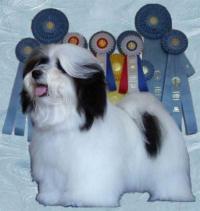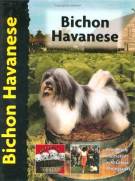Havanese Puppies available from Canadian Puppy & Dog Breeders in BC
|
|
|
|
These Havanese Puppy and Dog
Breeders can be found in
British Columbia, Canada
They will ship World Wide
|
|
Boys
|
Girls
|
Puppies
|
Photos
|
Links
|
|
|
Visit our NEW WEBSITE: MISTYTRAILS.ca
Ultra-Sweet 100% Pure Havanese Puppies for the Discerning Dog Fancier.
Specializing in QUALITY Havanese - raised with love - shown with pride!
Well bred, well socialized puppies available to approved homes.
Havanese Dog Breed Information Including History
|
|
See Discovery's Animal Planet video on the Havanese
HERE
Havanese Dog Breed Profile
This adorable breed boasts the distinction of being the
Cuban national dog breed.
Although the Havanese is new to the AKC and CKC, the breed
has been in existence in it's native Cuba for centuries as
a treasured family pet, Bred to play with children in the
courtyards of aristrocratic cubans. Through the years, the
Havanese has been bred for companionship. It's gorgeous good
looks and endearing personality make the breed a wonderful
house pet. The Havanese is a VERY social animal, that
treats all with a friendly welcome.
|
 Click to enlarge
Click to enlarge
|
|
A hypoallergenic Toy breed, the Havanese ranges in height
from 8 to 12 inches and weighs from 7 to 16 pounds. He has
large, dark and appealing eyes. The non-shedding coat is
long, soft, straight to wavy, and like human hair, is
odourless when wet. The breed comes in a rainbow of colors,
from white to shades of cream, champagne, gold, black, blue,
silver, chocolate or any combination of these. The plumed
tail is carried over the back.
Because the Gene pool of this rare breed is small, be sure
to view pedigrees to make sure the dog is bred well.
This breed is truly, the most TRENDIEST, friendliest and
popular companion breed of our era.
The CKC has an information sheet on the "Breed Standard" that can be seen at:
www.ckc.ca/en/Portals/0/pdf/breeds/HVN.pdf
|
|
Origin & Purpose
The breed comes from the Western Mediterranean region and has developed along the Spanish and
Italian coastal region. It would seem that these dogs were imported early to Cuba by sea
captains. Erroneously, the most frequent brown colour of these dogs (tobacco) gave birth to
the legend which would mean it to be a breed originating from Havana, capital of Cuba.
Political events led to the total disappearance of the old bloodlines of the Havanese in
Cuba; apparently a few dogs were successfully smuggled out of Cuba whose descendants have
survived in the U.S.A.
General Appearance
The Havanese is a sturdy little dog, low on his legs, with long abundant hair, soft and
preferably wavy. His movement is lively and elastic.
Temperament
Exceptionally bright he is easy to train as a watchdog dog. Affectionate, of a happy nature,
he is amiable, a charmer, playful and even a bit of a clown. He loves children and plays
endlessly with them.
Size
Height at the withers from 9-10.6 inches (23-27 cm). Tolerance from 8-11.4 inches (21-29 cm).
Coat & Colour
Hair: undercoat woolly and not very developed; it is often totally absent. The topcoat is very
long 5-7 inches (12-18 cm in adult dog), soft, flat or wavy and may form curly strands. The
usage of scissors to even out the length of the coat and all trimming is forbidden. Exception:
tidying up the hair on the feet is permitted, the hair on the forehead may be slightly shortened
so that it does not cover the eyes and the hair on the muzzle may be slightly tidied up, but it
is preferable to leave it in natural length.
Colour: there are two varieties of colour. Rarely completely pure white; fawn in its different
shades of light fawn to havana-brown (tobacco colour, reddish brown); patches in those colours
of coat; slight blackened overlay admitted. Permissible colours and patches (white, light
fawn to havana-brown) with black markings. Black coat.
Head
Of medium length, the relation between the length of the head and that of the trunk (measured
from the withers to the base of the tail) is 3/7. Skull: flat to very slightly rounded, broad;
forehead rising; seen from above it is rounded at the back and almost straight and square on
the other three sides. Stop: moderately marked. Nose: black. Muzzle: narrowing progressively
and slightly towards the nose but neither snipey nor truncated. Lips: fine, lean, tight.
Jaws/Teeth: scissors bite. A complete dentition is desirable. The absence of premolars 1
(PM1) and molars 3 (M3) is tolerated. Cheeks: very flat, not prominent. Eyes: quite big, almond
shape, of brown colour as dark as possible. Kind expression. The eye rims must be dark brown
to black. Ears: set relatively high; they fall along the cheeks forming a discreet fold which
raises them slightly. Their extremity is in a lightly rounded point. They are covered with hair
in long fringes. Neither propeller ears (sticking sideways), nor stuck to the cheeks.
Neck
Of medium length
Forequarters
Forelegs straight and parallel, lean; good bone structure. The distance from the ground to the
elbow must not be greater than that between the elbow and the withers.
Body
The length of the body is slightly superior to that of the height at the withers.
Topline straight, slightly arched over the loin. Croup noticeably inclined. Ribs well sprung.
Belly well tucked up.
Hindquarters
Good bone structure; moderate angulations. Feet of slightly elongated shape; small; tight toes.
Tail
Carried high, either in shape of a crozier or preferably rolled over the back; it is furnished
with feathering of long silky hair.
Gait
According to his happy nature, the Havanese has a strikingly light-footed and elastic gait;
forelegs with free stride and pointing straight forward, the hindlegs giving them the impulsion
and moving in a straight line.
Faults
Any departure from the foregoing points should be considered a fault and the seriousness with
which the fault should be regarded should be in exact proportion to its degree.
- General appearance lacking in type
- Truncated or snipey muzzle, length not identical to that of the skull
- Bird of prey eyes; eyes too deep set or prominent; rims of eyelids partially depigmented
- Body too long or too short
- Straight tail, not carried high
- French front (pasterns too close, feet turned outwards)
- Deformed hind feet
- Coat harsh, not abundant; hair short except on puppies; groomed coat
Disqualification
- Depigminted nose
- Upper or lower prognathism
- Ectropion, entropion; rim of eyelids of one or both eyes depigmented
- Size over or under the indicated norms of the standard
N.B.: Male animals should have two apparently normal testicles fully descended into the scrotum.
|
 Click to Enlarge
Click to Enlarge
|
A Great Book on the Havanese
There are a few Havanese books on the Market, but this one written
and published by our friend Zoila, in CUBA, is by far our personal
favortite.
This book is available from Emily & Bev at:
mistytrails@uniserve.com, amd from
Amazon.com
Bichon Havanese (Pet Love)
by Ziola Portuondo Guerra (Hardcover - September 16, 1999)
This version, of Zoila's book, called Bichon Havanese, is
recomended over the New Version of her book, published in
South Korea, "KennelClubBook: Havanese"
|
|
|
This website built and maintained by
MSR Web Design at Meadow Springs Ranch
|
|